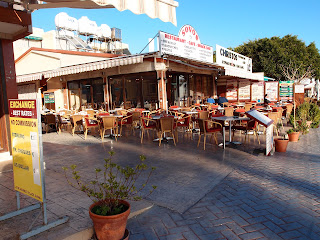After a good shower and some cheese from our fridge supply, we drove up to Ktima Paphos (the old town perched on the hill) in search of the two museums we knew to be open on Monday. Having struggled to find a free spot, I parked in a cactus and we proceeded to the Byzantine Museum via the municipal gardens. Opposite was a shop called "Thesis". They were having a sale. No comment. We left our staff in a locker in the main entrance and the proprietor showed us the oldest icon – 1300 years old. "10 years younger than me," he said. The icons were beautiful – all painted directly onto the wood and using texture as well as colour, with intricate patterns carved into the halos. I was eavesdropping on some German women who seemed to know their stuff and were discussing each icon as they walked around. I think the gist of what they were saying is that the style remained remarkably consistent throughout the centuries of Venetian rule. The lost some of their credibility, however, when one of them described the Madonna and child collection as “ein Babyfest” – I know Christoph assures me there is no such word in German, but (a) that never stopped a German before and (b) I know what I heard. There was a room of vestments and Bethhad guessed correctly that my favourite would be the purple one, with gold embroidery. She picked out a crown to match, and it's sweet that she thinks they'll make me a bishop by the end of the fortnight.
Andreas, the proprietor, showed us the icons that he made himself and showed me my name saint, Katerina. "This is you, see, with the crown." They clearly appreciate me here. He told us how he started sculpting icons to make ends meet when it was illegal to have more than one job in Cyprus – so he didn't get caught be changed a letter of his name on the packaging. Then when I bought icons he insisted I have a free postcard of his church at Geroskipou, and said we must visit there. He also plied us with Cyprus Delight (think Turkish delight only definitely not Turkish) – "one for the road?"
We retraced our steps to the Ethnographical Museum, housed in a large still occupied home. Opposite Beth spied a vestment tailoring shop and went in to ogle fabrics. The lower level of the museum was laid out as a traditional Cypriot dwelling – a classic hot country rooms-off-courtyard set up.
They have quite the collection of farm implements and workshop items that show how labour-intensive ordinary life was until very recently.
This ingenious contraption is a hand-powered olive press, with the initial crushing done by the big rock bit and the oil finally collected using the wooden machine to the rear.
This is a chapel in a cave off the courtyard.
Returning to the car we we left in the large cactus, we climbed in (only slightly perforated) and followed the war in the streets over to the bazaar end of town, where we parked by the mosque in the Mouflattos area. A cafe on the corner offered a "mosque special" takeaway coffee.
The market was eerily deserted, except for the German ladies from the Byzantine Museum. The random cluster of postcard and magnet stands sent me on a payment odyssey to three stalls - which is how I found out that they were closing for a siesta. We had our own siesta at a cafe, outdoors overlooking Kato Paphos and the sea.
We enjoyed mixed kebabs in a leisurely manner then returned to the hotel to lounge in the common area. Beth got online and we watched the Big Bang Theory. I wrote up my journal! We ate from our fridge supply watching New Tricks. I ended the evening drifting off in the lobby as Beth asked, "Kathleen, are you being mesmerised by the lamp?"
Yes, Beth. Yes, I was.















